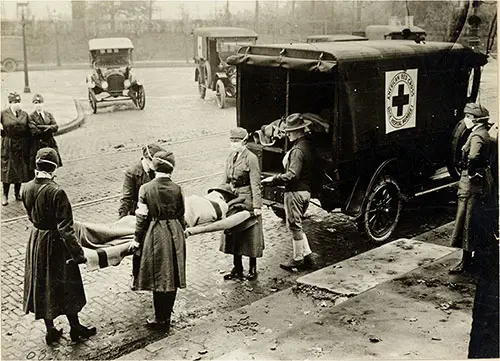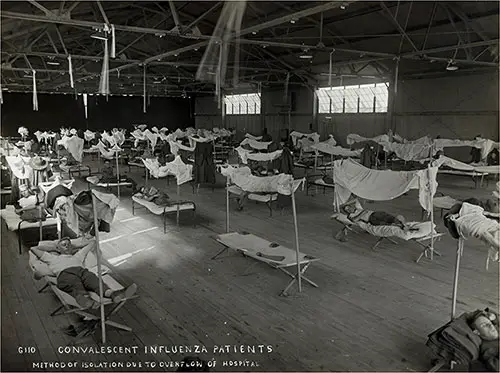Is the Influenza a Chinese Plague? - 1918

Red Cross Motor Corps on Duty St. Louis, Missouri, Circa October 1918. Photograph Courtesy of the American Red Cross. National Archives and Records Administration RG 65-WW-269B-3. NARA ID # 45499293. GGA Image ID # 1508d4b79b
Acts Tending to Identify the recent epidemic of influenza with a form of pneumonic plague that has raged in parts of China for several years past are adduced in The Medical Record (New York, 12 October 1918), by Capt. James Joseph King, of the United States Army Medical Corps.
Dr. King believes that the plague was taken to France by Chinese coolies[1] imported as laborers, whence it spread over Europe in modified form. The symptoms of the two diseases are similar, he says, and some of them have differed from those observed in previous epidemics.
Both diseases seem to be due to groups of different germs, and some of these have been definitely found in both. Dr. King thinks the coolies had among them "carriers" of the plague bacillus, and that this assumed new virulence and different form when transplanted into virgin soil.
We read in The Record.
"We desire to present in this preliminary note a consideration of the similarity of the present epidemic to the epidemic of pneumonic plague which broke out in Harbin, China, in October, 1910, and spread rapidly and continuously throughout northern China at that time; and to suggest that this epidemic may be the same disease modified by racial and topographical differences.
The origin of this epidemic was suggested to the writer soon after its outbreak in our camps by Mr. Guy M. Walker, an eminent American authority on Chinese affairs.
This suggestion led to an investigation of the reports of the pneumonic plague in China, and there is sufficient likeness of that epidemic to the present one prevailing in our cities and army camps to warrant a consideration of it.
"In the latter part of 1910 the pneumonic plague first appeared in Harbin, a town in Manchuria under Chinese control. Harbin is on the Trans-Siberian Railroad, and was the original hotbed of the disease… From Harbin the plague rapidly spread in all directions, usually following the lines of traffic along the railroads …
"This plague has been very serious. The mortality has been fearfully high. It has spread throughout China. Wherever the Chinese coolies from the North have traveled they have carried this disease…
"In the early part of 1917, about 200,000 Chinese coolies, collected from the northern part of China, where the pneumonic plague has raged at intervals since 1910, were sent to France as laborers…

Convalescent Influenza Patients, Method of Isolation Due to Overflow of Hospital at Eberts Field, Lonoke, Arkansas. Photograph D.M.A. circa 7 November 1918. National Archives and Records Administration RG 165-WW-269B-0. NARA ID # 45499287. GGA Image ID # 150860d421
"They made splendid laborers in France and were in back of the lines during the German drive of March 1918. No doubt many of them were captured by the Germans at that time. Hence the outbreak of it in the German Army and its rapid spread in Spain.
"So far as we know, this disease first broke out last spring, in the German Army, where it is said to have been very serious. We next heard of it in Spain, hence the name Spanish influenza. The name is really a misnomer, but it has stuck, probably because it is the first epidemic of influenza that Spain has ever had.
Since our soldiers and sailors have been returning from the battlefields of France it has become very prevalent and serious in our camps and cities all over this country.
"It is not necessary here to go into detail concerning the clinical data, except in a very general way. In the China epidemic there were few definite symptoms at the outset of the disease except the general malaise prostration, loss of appetite, etc., soon to be followed by the pneumonic process and death.
"So it is in the present epidemic. There have been indefinite symptoms, great prostration rapidly followed by pneumonia and death in the most virulent forms. The outstanding features of the Chinese pneumonic plague were the high infectivity of it and the high mortality.
"So in this so-called influenza epidemic it is more contagious, is followed more frequently by pneumonia, and attended with a much higher mortality than in any previous influenza epidemic."
In the pneumonic plague epidemic of China, Dr. King goes on to say, the typical plague bacillus was found associated with the germs of pneumonia and similar diseases.
Different strains of these organisms were found in different localities, and the virulence of the disease varied accordingly. In our influenza epidemic the influenza bacillus has also been associated with groups of these same germs, varying in character as the virulence and mortality of the disease have varied.
He goes on:
"Thus we have shown a striking similarity between the pneumonic plague of North China and the present so-called Spanish influenza epidemic. It is not unreasonable to believe that the two diseases may be the same.
"The influenza bacillus and the Bacillus peslis (plague bacillus), in atypical forms, may simulate each other. We know that organisms may assume different forms and have different cultural characteristics in different conditions.
"The ordinary influenza bacillus is a short, slender bacillus. The plague bacillus is about the same length, but is generally fatter and broader… It seems possible that the Bacillus pestle may have been present in a non-virulent state in the Chinese coolies, and assumed new virulence, vigor, and a somewhat different form, when transplanted into virgin soil. The high mortality and infectivity of this epidemic strongly suggest it.
"On this basis the epidemics which have followed all great wars may be explained. If a nation or tribe can survive any disease long enough it will acquire immunity to that disease.
"When, however, foreign people commingle freely and intimately, as in war, epidemics will break out. The inactive, non-virulent organisms in one race will become virulent in some other race which has not acquired immunity to that specific organism."
"Is the Influenza a Chinese Plague?" in The Literary Digest, 7 December 1918, p. 26-27.
Note 1 Coolie is an unskilled native laborer in India, China, and some other Asian countries. Coolie has a variety of other implications and is sometimes regarded as offensive or a pejorative, depending upon the historical and geographical context. It is similar, in many respects, to the Spanish term peón, although both terms are used in some countries, with slightly differing implications.
